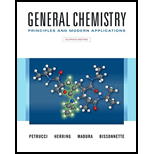
Concept explainers
(a)
Interpretation:
Difference between coordination number and oxidation number is to be defined.
Concept introduction:
When all the ligands and shared paired electron are removed from a coordination compound, the number of charge on central metal is called oxidation number. And a number of ligands are known as co-ordination number.
(b)
Interpretation:
Difference between monodentate and polydentate is to be defined.
Concept introduction:
During metal-ligand complex formation different ligands bind to the central metal ion which is known as coordination compound. Ligands can be of two types monodentate and polydentate.
(c)
Interpretation:
Difference between cis and trans isomers is to be defined.
Concept introduction:
The phenomenon of isomers having different structural composition is known as Structural isomerism. Isomers can be present in different forms known as Cis and Trans-forms.
(d)
Interpretation:
Difference Dextro and Levo rotatory are to be defined.
Concept introduction:
The phenomenon of isomers having different structural composition is known as Structural isomerism. And the isomers can rotate the plane-polarized light and can be divided into Dextro and Levo rotatory.
(e)
Interpretation:
Difference between low spin and high spin complex is to be defined.
Concept introduction:
According to crystal field theory splitting of d orbital occurs which leads to energy emission in the form of light. Here crystal field splitting is presented as
Want to see the full answer?
Check out a sample textbook solution
Chapter 24 Solutions
Mastering Chemistry With Pearson Etext -- Standalone Access Card -- For General Chemistry: Principles And Modern Applications (11th Edition)
- Define the ambidentate ligand and give two examples.arrow_forwardGive examples of three complexes containing Mn metal with different ligand(s) and representing at least two - geometries. Describe any significant features of Mn metal - ligand bonding and identify any unusual or otherwise notable features of the bonding associated with these three examples.arrow_forwardBoth H2O and ethylenediamine (en) have two nonbonding pairs of electrons. Whycan en act as a bidentate ligand whereas water cannot?arrow_forward
 Principles of Modern ChemistryChemistryISBN:9781305079113Author:David W. Oxtoby, H. Pat Gillis, Laurie J. ButlerPublisher:Cengage Learning
Principles of Modern ChemistryChemistryISBN:9781305079113Author:David W. Oxtoby, H. Pat Gillis, Laurie J. ButlerPublisher:Cengage Learning Chemistry: Principles and ReactionsChemistryISBN:9781305079373Author:William L. Masterton, Cecile N. HurleyPublisher:Cengage Learning
Chemistry: Principles and ReactionsChemistryISBN:9781305079373Author:William L. Masterton, Cecile N. HurleyPublisher:Cengage Learning Chemistry: Principles and PracticeChemistryISBN:9780534420123Author:Daniel L. Reger, Scott R. Goode, David W. Ball, Edward MercerPublisher:Cengage Learning
Chemistry: Principles and PracticeChemistryISBN:9780534420123Author:Daniel L. Reger, Scott R. Goode, David W. Ball, Edward MercerPublisher:Cengage Learning


